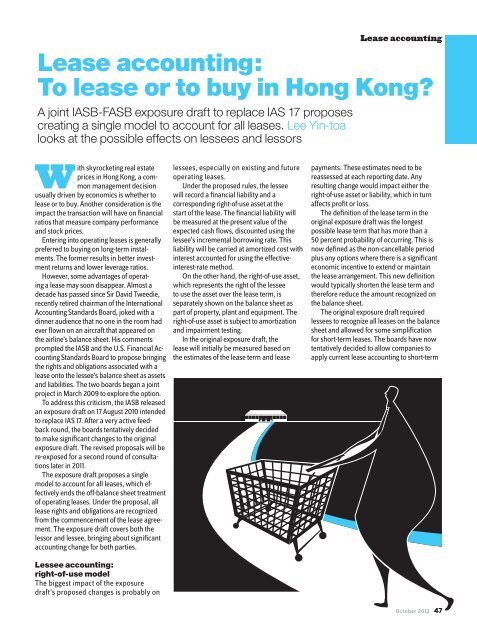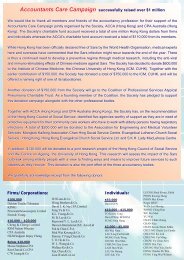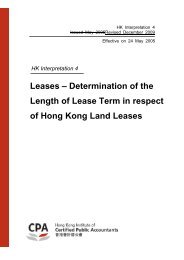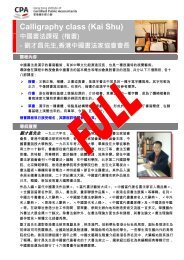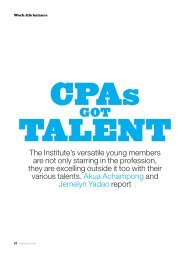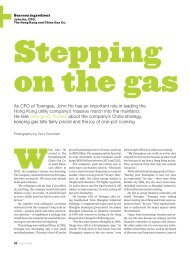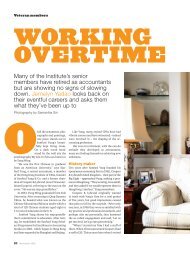Lease accounting - Hong Kong Institute of Certified Public Accountants
Lease accounting - Hong Kong Institute of Certified Public Accountants
Lease accounting - Hong Kong Institute of Certified Public Accountants
Create successful ePaper yourself
Turn your PDF publications into a flip-book with our unique Google optimized e-Paper software.
<strong>Lease</strong> <strong>accounting</strong>:<br />
To lease or to buy in <strong>Hong</strong> <strong>Kong</strong>?<br />
A joint IASB-FASB exposure draft to replace IAS 17 proposes<br />
creating a single model to account for all leases. Lee Yin-toa<br />
looks at the possible effects on lessees and lessors<br />
With skyrocketing real estate<br />
prices in <strong>Hong</strong> <strong>Kong</strong>, a common<br />
management decision<br />
usually driven by economics is whether to<br />
lease or to buy. Another consideration is the<br />
impact the transaction will have on financial<br />
ratios that measure company performance<br />
and stock prices.<br />
Entering into operating leases is generally<br />
preferred to buying on long-term instalments.<br />
The former results in better investment<br />
returns and lower leverage ratios.<br />
However, some advantages <strong>of</strong> operating<br />
a lease may soon disappear. Almost a<br />
decade has passed since Sir David Tweedie,<br />
recently retired chairman <strong>of</strong> the International<br />
Accounting Standards Board, joked with a<br />
dinner audience that no one in the room had<br />
ever flown on an aircraft that appeared on<br />
the airline’s balance sheet. His comments<br />
prompted the IASB and the U.S. Financial Accounting<br />
Standards Board to propose bringing<br />
the rights and obligations associated with a<br />
lease onto the lessee’s balance sheet as assets<br />
and liabilities. The two boards began a joint<br />
project in March 2009 to explore the option.<br />
To address this criticism, the IASB released<br />
an exposure draft on 17 August 2010 intended<br />
to replace IAS 17. After a very active feedback<br />
round, the boards tentatively decided<br />
to make significant changes to the original<br />
exposure draft. The revised proposals will be<br />
re-exposed for a second round <strong>of</strong> consultations<br />
later in 2011.<br />
The exposure draft proposes a single<br />
model to account for all leases, which effectively<br />
ends the <strong>of</strong>f-balance sheet treatment<br />
<strong>of</strong> operating leases. Under the proposal, all<br />
lease rights and obligations are recognized<br />
from the commencement <strong>of</strong> the lease agreement.<br />
The exposure draft covers both the<br />
lessor and lessee, bringing about significant<br />
<strong>accounting</strong> change for both parties.<br />
Lessee <strong>accounting</strong>:<br />
right-<strong>of</strong>-use model<br />
The biggest impact <strong>of</strong> the exposure<br />
draft’s proposed changes is probably on<br />
lessees, especially on existing and future<br />
operating leases.<br />
Under the proposed rules, the lessee<br />
will record a financial liability and a<br />
corresponding right-<strong>of</strong>-use asset at the<br />
start <strong>of</strong> the lease. The financial liability will<br />
be measured at the present value <strong>of</strong> the<br />
expected cash flows, discounted using the<br />
lessee’s incremental borrowing rate. This<br />
liability will be carried at amortized cost with<br />
interest accounted for using the effectiveinterest-rate<br />
method.<br />
On the other hand, the right-<strong>of</strong>-use asset,<br />
which represents the right <strong>of</strong> the lessee<br />
to use the asset over the lease term, is<br />
separately shown on the balance sheet as<br />
part <strong>of</strong> property, plant and equipment. The<br />
right-<strong>of</strong>-use asset is subject to amortization<br />
and impairment testing.<br />
In the original exposure draft, the<br />
lease will initially be measured based on<br />
the estimates <strong>of</strong> the lease term and lease<br />
$ $ $<br />
<strong>Lease</strong> <strong>accounting</strong><br />
payments. These estimates need to be<br />
reassessed at each reporting date. Any<br />
resulting change would impact either the<br />
right-<strong>of</strong>-use asset or liability, which in turn<br />
affects pr<strong>of</strong>it or loss.<br />
The definition <strong>of</strong> the lease term in the<br />
original exposure draft was the longest<br />
possible lease term that has more than a<br />
50 percent probability <strong>of</strong> occurring. This is<br />
now defined as the non-cancellable period<br />
plus any options where there is a significant<br />
economic incentive to extend or maintain<br />
the lease arrangement. This new definition<br />
would typically shorten the lease term and<br />
therefore reduce the amount recognized on<br />
the balance sheet.<br />
The original exposure draft required<br />
lessees to recognize all leases on the balance<br />
sheet and allowed for some simplification<br />
for short-term leases. The boards have now<br />
tentatively decided to allow companies to<br />
apply current lease <strong>accounting</strong> to short-term<br />
October 2011 47
<strong>Lease</strong> <strong>accounting</strong><br />
<strong>Lease</strong><br />
Buy<br />
or<br />
leases. Therefore, companies would not be<br />
required to recognize lease-related assets<br />
and liabilities for short-term leases.<br />
Taking into account expected lease<br />
payments – such as contingent rentals,<br />
penalties and residual value guarantees – it<br />
was suggested that reporting figures entailed<br />
by the original exposure draft could be<br />
speculative and might not represent present<br />
obligations on the balance sheet.<br />
In the re-deliberations, the boards instead<br />
suggested that contingent payments based<br />
on performance and usage be recognized as<br />
expenses as they are incurred, which reduced<br />
the amounts recognized on the balance sheet.<br />
Business implications<br />
for lessees<br />
For lessees, the most visible impact <strong>of</strong> the<br />
exposure draft’s proposed changes would<br />
be the “grossing up” <strong>of</strong> the balance sheet<br />
to include amounts that are <strong>of</strong>f the balance<br />
sheet under the current lease <strong>accounting</strong><br />
standards. Instead <strong>of</strong> being recognized as a<br />
rental expense over the lease period under<br />
the operating lease model, leases will now be<br />
recognized upfront as an asset. As a result <strong>of</strong><br />
the on-balance sheet treatment, some debtto-equity<br />
ratios may deteriorate even if cash<br />
flow and business activities stay the same.<br />
For certain regulated financial institutions<br />
– such as banks, securities companies and<br />
insurers in <strong>Hong</strong> <strong>Kong</strong> – the additional<br />
asset booking might attract capital charges<br />
depending on how regulators such as the<br />
<strong>Hong</strong> <strong>Kong</strong> Monetary Authority, the Securities<br />
48 October 2011<br />
and Futures Commission and the Office <strong>of</strong><br />
the Commissioner <strong>of</strong> Insurance react to the<br />
proposed changes. In addition, the lease<br />
expense would be replaced by an interest<br />
expense on the financial liability and the<br />
right-<strong>of</strong>-use asset would have a depreciation<br />
expense. Both could make a difference to the<br />
amount <strong>of</strong> corporate income taxes levied by<br />
the Inland Revenue Department.<br />
While debt coverage ratios will suffer,<br />
earnings before interest and tax or earnings<br />
before interest, taxes, depreciation and<br />
amortization are likely to improve. However,<br />
the reassessment <strong>of</strong> lease cash flows on an<br />
ongoing basis will also result in volatility in<br />
net assets and income. Finally, operating<br />
cash flows will improve because lease<br />
payments will now be recognized under both<br />
performance obligation and de-recognition<br />
models as receivables at the inception <strong>of</strong><br />
the lease. Accordingly, the balance sheet<br />
will grow under the performance obligation<br />
model and financial ratios will change.<br />
These changes could affect loan covenants,<br />
financing deals and even regulatory<br />
requirements. Companies providing<br />
remuneration incentives may also need to<br />
reassess whether some formulas used in<br />
reward calculations remain appropriate.<br />
Since the exposure draft would require<br />
continuous reassessment <strong>of</strong> lease<br />
assumptions, a company may need to<br />
establish policies and design processes and<br />
controls to ensure that reliable input from<br />
departments is promptly gathered, analysed<br />
and processed.<br />
Companies should also consider whether<br />
their management information systems are<br />
sufficient. Some may choose to customize<br />
their systems while others may choose to<br />
buy s<strong>of</strong>tware developed once the exposure<br />
draft advances to a final standard.<br />
The changes proposed in the exposure<br />
draft will also affect the structuring <strong>of</strong> lease<br />
contracts. For instance, shorter leases will<br />
have a smaller impact on the balance sheet<br />
and on the long-term volatility <strong>of</strong> financial<br />
statements, and vice versa for larger leases.<br />
However, a leased asset or liability may<br />
still be required to reflect the impact <strong>of</strong><br />
renewal option periods. If options are not<br />
included, the lessee is likely to be concerned<br />
about the security <strong>of</strong> asset, especially with<br />
<strong>Hong</strong> <strong>Kong</strong>’s escalating real estate rental<br />
prices. Lessees should balance the financial<br />
statement implications <strong>of</strong> short-term leases<br />
with the cost <strong>of</strong> constantly renewing these<br />
arrangements.<br />
Certain industries such as independent<br />
power producers and semiconductor<br />
companies have build-operate-transfer, buildoperate-own<br />
or similar contracts that may<br />
contain lease arrangements now classified<br />
as operating leases. Under the exposure<br />
draft, these contracts should be revisited<br />
and may result in “grossing up” the balance<br />
sheet. Given the context under which these<br />
contracts are entered into – that is, long-term<br />
project finance-type infrastructure projects –<br />
any “grossing up” <strong>of</strong> balance sheet line items<br />
will probably affect sensitive financial ratios<br />
<strong>of</strong> existing loan covenants.
Lessor <strong>accounting</strong>:<br />
performance-obligation model<br />
Two models are being proposed for lessors.<br />
For leases that do not substantially transfer<br />
to the lessee the risks and rewards related to<br />
the underlying assets, the lessor will apply<br />
the performance-obligation model.<br />
This model assumes that the asset<br />
remains an economic resource <strong>of</strong> the lessor;<br />
hence it is retained in the lessor’s books. This<br />
asset will be depreciated over its useful life<br />
and subject to impairment testing.<br />
The performance-obligation model also<br />
requires that the lessor initially records a<br />
lease receivable net <strong>of</strong> any initial direct cost,<br />
calculated at the present value <strong>of</strong> expected<br />
lease charges over the lease term. This asset is<br />
carried at amortized cost with interest being<br />
recognized using the effective-interest-rate<br />
method. It also requires the lessor to record a<br />
performance obligation liability initially equal<br />
to the amount <strong>of</strong> the recorded receivable. The<br />
amount is then subsequently amortized on<br />
a systematic basis – usually straight-line – as<br />
lease revenue over the lease term.<br />
Since the lease receivable and related<br />
liability are initially measured based on<br />
expected cash flows specified in the lease<br />
agreement, the lessor is required to reassess<br />
the receivable’s carrying amount if facts or<br />
circumstances indicate that there would be<br />
a significant change in the right to receive<br />
lease payments since the previous reporting<br />
period. This is expected to create volatility in<br />
the financial statements.<br />
Under the performance obligation model,<br />
the balance sheet will reflect the following<br />
line items: the leased assets as property<br />
under lease, plus the lease receivable less the<br />
amount <strong>of</strong> performance obligation. This will<br />
result in either a net asset or net liability.<br />
Lessor <strong>accounting</strong>:<br />
de-recognition model<br />
For other leases, where the risks and<br />
rewards are presumed to have been<br />
substantially transferred to the lessee, the<br />
lessor will apply the de-recognition model.<br />
The lessor will de-recognize the underlying<br />
asset and recognize a lease receivable and a<br />
residual asset representing the portion <strong>of</strong> the<br />
underlying leased asset that is retained with<br />
the lessor. This residual asset represents an<br />
allocation <strong>of</strong> the carrying value <strong>of</strong> the leased<br />
asset. It is based on the relative fair value<br />
<strong>of</strong> the residual asset to the fair value <strong>of</strong> the<br />
underlying asset calculated at inception <strong>of</strong> the<br />
lease. The allocation requires a considerable<br />
degree <strong>of</strong> judgment and estimation.<br />
Similar to the performance-obligation<br />
model, the lessor will record a lease<br />
receivable. The receivable is calculated<br />
as the present value <strong>of</strong> the expected lease<br />
charges net <strong>of</strong> initial direct costs with<br />
interest accounted for using the effectiveinterest-rate<br />
method.<br />
After initial recognition, the lessor is<br />
required to reassess the lease term if there is<br />
any indication <strong>of</strong> change. The effect <strong>of</strong> such<br />
reassessment results in an adjustment to the<br />
rights de-recognized in pr<strong>of</strong>it or loss, or the<br />
residual asset.<br />
The lessor is also required to reassess<br />
the expected amount <strong>of</strong> any contingent<br />
rentals and any expected payments<br />
under term-option penalties and residual<br />
value guarantees, with resulting changes<br />
recognized in pr<strong>of</strong>it or loss.<br />
On the balance sheet, the lessor is<br />
required to separately present as assets<br />
the lease receivable and the residual asset<br />
which is presented as part <strong>of</strong> property, plant<br />
and equipment.<br />
Business implications<br />
to lessors<br />
As lessees might prefer short-term leases,<br />
lessors would bear the risks <strong>of</strong> higher<br />
financing costs and non-renewal <strong>of</strong> shortterm<br />
contracts. In an effort to cushion the<br />
effect <strong>of</strong> the exposure draft, some companies<br />
may consider modifying existing lease<br />
contracts while others may explore buying<br />
assets instead.<br />
The lease will initially be measured<br />
based on the estimates <strong>of</strong> the lease term,<br />
contingent rentals, penalties and residual<br />
value guarantees. These estimates need to<br />
be reassessed at each reporting date. Any<br />
resulting change would impact either the<br />
right-<strong>of</strong>-use asset and liability, which then<br />
affects pr<strong>of</strong>it or loss.<br />
Similar to lessees, lessors’ re-measurements<br />
relating to the estimates <strong>of</strong> the lease term,<br />
contingent rentals, penalties and residual<br />
value guarantees are expected to create<br />
volatility in financial statements.<br />
Certain lessors specializing in operating<br />
leases, such as car leasing companies, may<br />
have to review business models as customer or<br />
lessee preference may shift given the proposed<br />
on-balance sheet recognition <strong>of</strong> all leases.<br />
Conclusion<br />
As entities structure new leases or modify<br />
existing ones in light <strong>of</strong> the new exposure<br />
draft, current and deferred tax implications<br />
should be considered now that we have<br />
A PLUS<br />
the new exposure draft. Assessing tax<br />
implications early would help companies<br />
reduce tax risks from the IRD.<br />
The boards plan to issue the second<br />
exposure draft in the fourth quarter <strong>of</strong> 2011<br />
and publish a final standard in 2012. It is<br />
expected that the proposed standard will<br />
be applied to all leases existing as <strong>of</strong> the<br />
date <strong>of</strong> initial application. If the proposed<br />
standard takes effect in 2013, then all leases<br />
outstanding as <strong>of</strong> 1 January 2012 will have to<br />
be reviewed.<br />
This might present a significant challenge<br />
as some leases are already long outstanding.<br />
Some entities do not maintain a repository<br />
<strong>of</strong> contracts that can provide the necessary<br />
information needed for the transition.<br />
Entities should consider gathering lease<br />
related information on a systematic and<br />
real-time basis.<br />
However, the proposed on-balance<br />
sheet treatment is likely to be permanent.<br />
Companies are therefore strongly<br />
encouraged to conduct an early impact<br />
assessment <strong>of</strong> the exposure draft.<br />
Understanding the exposure draft better<br />
will help firms prepare and plan for the<br />
transition in a way that will help address<br />
<strong>accounting</strong>, tax, regulatory, process and<br />
system concerns.<br />
In light <strong>of</strong> the proposed on-balance sheet<br />
treatment <strong>of</strong> all leases, how is the line drawn<br />
between a leased asset and an owned one,<br />
from a financial reporting perspective?<br />
With IAS 17, firms classify leases either as an<br />
operating or a finance lease, given that the<br />
standard provides qualifying rules to allow<br />
an <strong>of</strong>f-balance sheet treatment <strong>of</strong> operating<br />
leases. With the exposure draft, such a<br />
distinction will disappear along with many<br />
lease structuring opportunities such as sale<br />
leaseback transactions.<br />
The World Leasing Yearbook 2010<br />
identified global leasing exposures in 2008<br />
as US$640 billion. This figure is not limited<br />
to firms with obvious large exposures to<br />
big-ticket items such as property and aircraft.<br />
It also includes large accumulated exposures<br />
to much smaller items such as vehicles and<br />
<strong>of</strong>fice equipment.<br />
When the new standard comes in effect,<br />
will it be better to lease or to buy? There<br />
might not be much difference after all.<br />
Lee Yin-toa is a partner and financial services leader <strong>of</strong><br />
financial <strong>accounting</strong> advisory services for Ernst & Young<br />
in the Asia Pacific.<br />
October 2011 49


